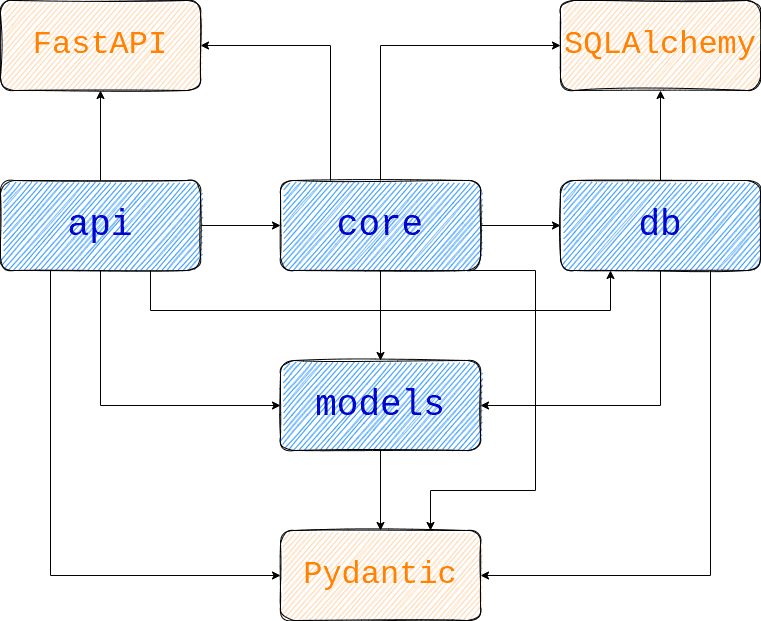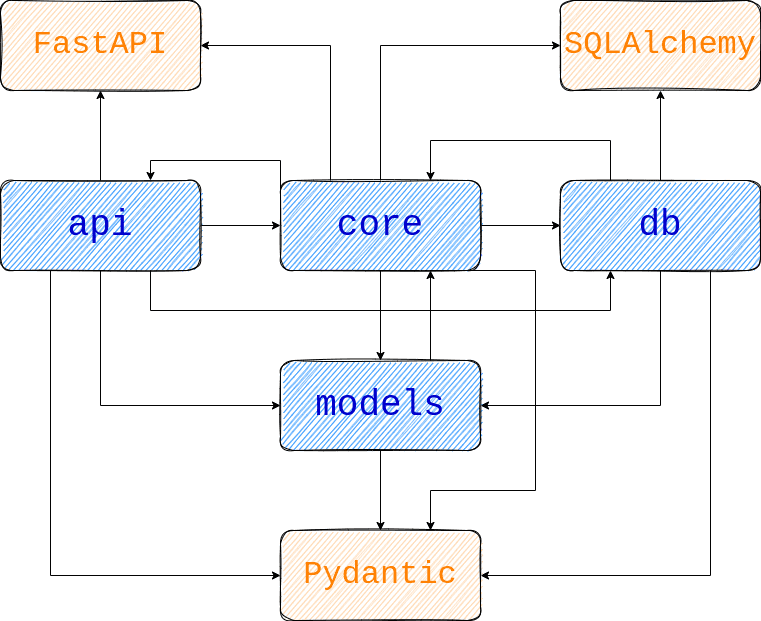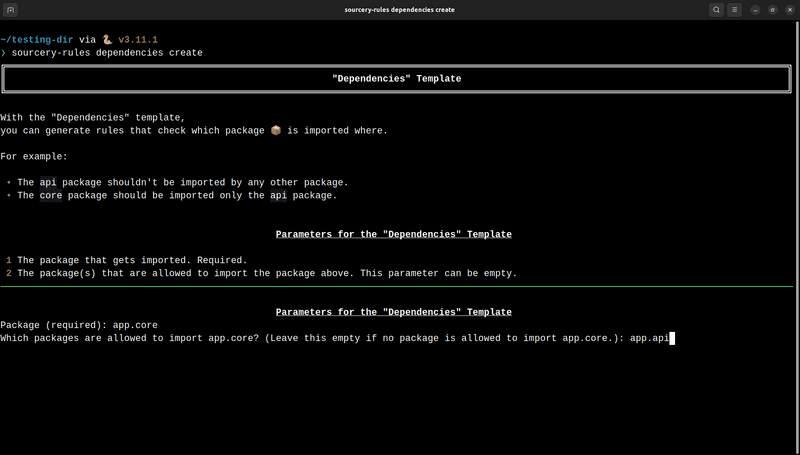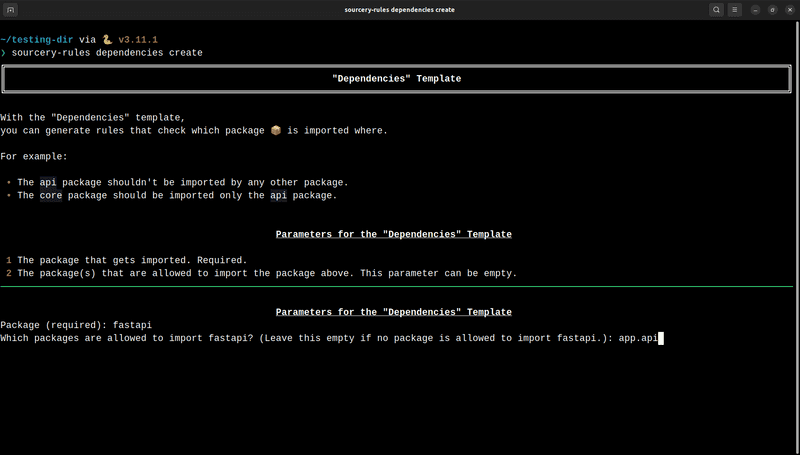Maintain A Clean Architecture With Dependency Rules
Disentangle the dependencies between your packages.
Dec 15, 2022

Packages, Dependencies, And Architecture
As soon as your application gets a bit bigger, you'll probably divide it into subsystems. In Python, this usually means packages. How well the boundaries between those packages are defined and how the communication flows between them greatly influences the maintainability of your project.
In this blog post, we're going to:
- Visualize the optimal flow of communication between packages.
- Phrase some rules (in English) about the dependencies between those packages based on the visual.
- Translate the rules into code, so that we can check how much our application follows the optimal architecture.
Following this example, you can create architecture rules for your own projects.
The Example API
We're using a FastAPI application as an example. It stores its data in a PostgreSQL database via SQLAlchemy. It's divided into 4 packages:
app.apiapp.coreapp.dbapp.schemas
Visualizing the Communication Between Packages
How do these packages communicate with each other? And with the external libraries powering them?
This might take many different forms. One possible architecture is this:

But it can also look something like this:

You can make things even more complicated by introducing circular dependencies:

While Python doesn't allow circular dependencies between modules, it won't stop you from introducing circular dependencies between packages.
The first architecture looks more simple. And this has some advantages:
- It's easier to understand and reason about.
- It's easier to see the consequences of a change.
- It's easier to replace a single element of the application.
Defining the Dependency Rules
Now, we have a picture of how these packages should communicate. Let's define some rules to achieve this architecture. First, we'll establish some rules on how the packages of our application communicate with each other:
- No other package depends on
api. - Only
apidependscore. - Only
coredepends ondb.
Let's turn to the external dependencies. We want to ensure that each of them is accessed only by the relevant package of our system:
- FastAPI from
api - SQLAlchemy from
db - Pydantic from
models
Note that you probably don't want to define such a rule for every single dependency. But for libraries that are a crucial part of the architecture, it's a good idea to keep the interface clean.
Express the Dependency Rules as Code
So far, we've defined the dependency rules of our system: in a picture and in some sentences. Let's see how it matches up with the reality of our system. 😏 For that, we'll take the rules from the previous section and translate them into code.
For this translation, we'll use the tool Sourcery Rules Generator It creates Sourcery's custom rules in YAML format based on your input. You can install it from PyPI:
pip install sourcery-rules-generatorSetting Up Our Boundaries
Let's start with the first rule:
No other package depends on api.
To create such a rule about dependencies, run the command:
sourcery-rules dependencies createYou'll see:
- a brief introduction to the Dependencies rule template
- a prompt where you can enter the package's name
- after that, a second prompt where you can enter which packages are allowed to import the first package
Provide the parameters, so that the dependency rules can be generated:
- In the first prompt, enter the fully qualified name of the package: app.api
- Leave the second prompt empty. (Because no package is allowed to import
app.api.)

Now, you'll get an output with 2 rules in YAML format:
- one detecting
importstatements - one detecting
from ... importstatements
These rules detect if app.api or any of its subpackages gets imported within
your project.
rules:
- id: dependency-rules-app-api-import
description: Do not import `app.api` in other packages
pattern: import ..., ${module}, ...
condition: module.matches_regex(r"^app\.api\b")
paths:
exclude:
- app/api/
- tests/
tags:
- architecture
- dependencies
- id: dependency-rules-app-api-from
description: Do not import `app.api` in other packages
pattern: from ${module} import ...
condition: module.matches_regex(r"^app\.api\b")
paths:
exclude:
- app/api/
- tests/
tags:
- architecture
- dependenciesWhat do these rules contain?
- A pattern with the syntax that we want to detect.
- A condition ensuring that the rule detects only imports referencing the
app.apipackage. - Some excluded paths: It's OK to reference the
app.apipackage in itself and in tests. - The
architectureanddependenciestags. This way, we can check for all the architecture rules together.
You can copy these rules into your projects .sourcery.yaml config file. For
that it's recommended to use the --plain option:
sourcery-rules dependencies create --plainNow, you can run the sourcery review command of the
Sourcery CLI to
check for these rules:
sourcery review --enable architecture .Further Rules for Internal Dependencies
Now, we can create similar Sourcery custom rules for our other internal dependency rules.
Only api depends core.
Again, we run the same command:
sourcery-rules dependencies createThis time, we fill both parameters:
app.coreis the packageapp.apiis the only package importing it

Again, 2 rules are created:
rules:
- id: dependency-rules-app-core-import
description: Only `app.api` should import `app.core`
pattern: import ..., ${module}, ...
condition: module.matches_regex(r"^app\.core\b")
paths:
exclude:
- app/core/
- tests/
- app/api/
tags:
- architecture
- dependencies
- id: dependency-rules-app-core-from
description: Only `app.api` should import `app.core`
pattern: from ${module} import ...
condition: module.matches_regex(r"^app\.core\b")
paths:
exclude:
- app/core/
- tests/
- app/api/
tags:
- architecture
- dependenciesYou can also create similar rules ensuring that only app.core should import
app.db.
Rules for External Dependencies
Let's turn to the rules regarding the external dependencies:
- Only
apidepends on FastAPI - Only
dbdepends on SQLAlchemy - Only
modelsdepends on Pydantic
We can create these rules the same way we did for the internal dependencies.
This time, the package won't be a package in our project, but an external
dependency.
Only app.api imports FastAPI.
sourcery-rules dependencies createThis time, we fill both parameters:
fastapiis the packageapp.apiis the only package importing it

Again, the output shows 2 rules:
rules:
- id: dependency-rules-fastapi-import
description: Only `app.api` should import `fastapi`
pattern: import ..., ${module}, ...
condition: module.matches_regex(r"^fastapi\b")
paths:
exclude:
- fastapi/
- tests/
- app/api/
tags:
- architecture
- dependencies
- id: dependency-rules-fastapi-from
description: Only `app.api` should import `fastapi`
pattern: from ${module} import ...
condition: module.matches_regex(r"^fastapi\b")
paths:
exclude:
- fastapi/
- tests/
- app/api/
tags:
- architecture
- dependenciesYou can create rules in the same way for the 2 other external dependencies as well:
- only
app.dbimports SQLAlchemy - only
app.modelsimports Pydantic
Now, we have 12 Sourcery custom rules to express our 6 architecture rules. We
can run all of them with the sourcery review command in the Sourcery CLI:
sourcery review --enable architecture .Generalization: Create Architecture Rules in Your Project
Following the examples above, you can create rules for dependencies in your own projects. The recommended steps:
- Draw a diagram showing the optimal dependencies between your packages.
- Phrase some rules in a human language based on the diagram: Which package should depend on which?
- Translate the rules into code with Sourcery custom rules with Sourcery Rules Generator.
If you're working on a huge application, don't try to tackle the whole architecture at once. Pick a subset of packages and go through the 3 steps with this smaller scope.
You can also check out the how-to guide Establish Rules for Dependencies Between Your Packages in the Sourcery docs.
Have you created architecture rules for your system? Do you have any questions, thoughts on this? Let us know.
Reach out at hello@sourcery.ai or on Twitter @SourceryAI. Join the Sourcery Discord Community.